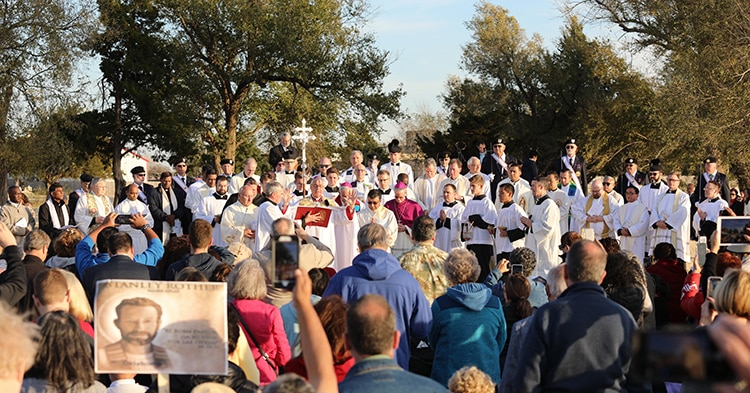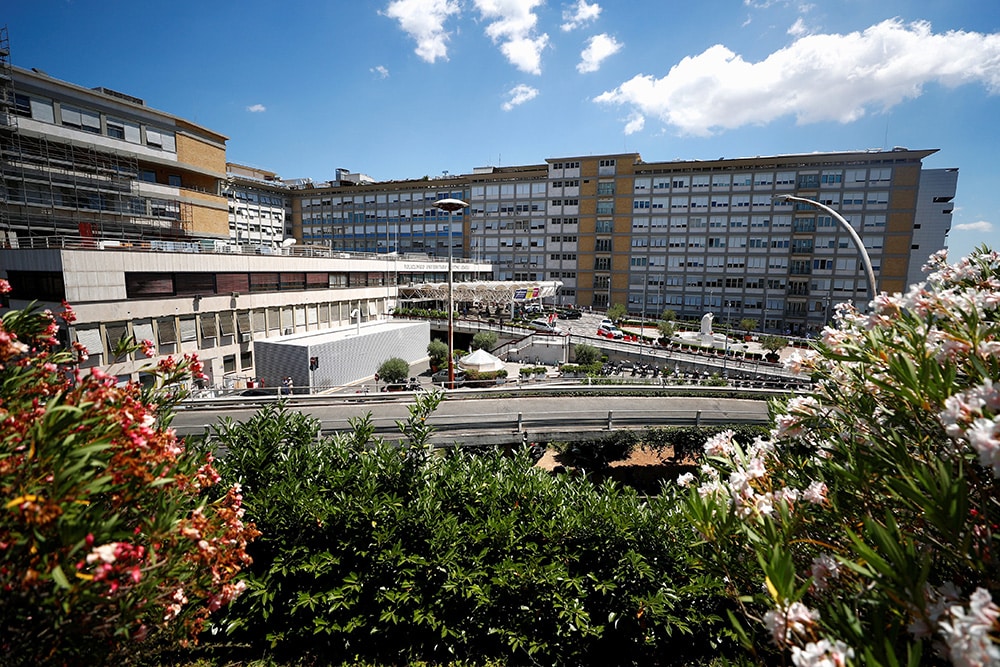Can you name all the saints born in the United States? The answer is easier than you likely think.
There are three. St. Katharine Drexel, St. Elizabeth Ann Seton and St. Kateri Tekakwitha. That’s it. That’s the list.
There are several American men who have recently been beatified, Father Stanley Rother among them, but no men born in the United States have been canonized — yet.
We are all called to be saints. And we need the examples of ordinary men and women who, like us, want to follow the path to holiness. We need them to be from our neck of the woods — people who have experienced the challenges, discriminations and events that are particular to American history and culture.
So, while we should all be grateful for the contributions of those who followed God’s call and came to the U.S. from elsewhere, it is time for the United States to have its own holy, homegrown, contemporary models.
And among the holy men who may soon be declared the first male American-born saint, Father Stanley Francis Rother stands out.
An ordinary martyr
In a culture of MVPs, superheroes and all-stars, Blessed Stanley Rother would be labeled as ordinary — and that’s precisely what makes him appealing. Like St. John Vianney, the Curé d’Ars, Stanley Rother’s struggles with academics almost prevented his ordination. After repeating one year of philosophy, failing the first year of theology and flunking out of one seminary, Stanley Rother questioned his vocation. Yet he faithfully persevered, eventually finding a home at Mount St. Mary’s Seminary in Emmitsburg, Maryland.
Rother was ordained on May 25, 1963, at the age of 28, for the then-Diocese of Oklahoma City and Tulsa, serving the first five years of his priestly ministry without much notice in various Oklahoma assignments.
“Perhaps what’s most inspiring about Father Rother is how ordinary and average he is,” said Auxiliary Bishop Daniel H. Mueggenborg of the Archdiocese of Seattle. “He was not gifted in any exceptional way. But he chose to say ‘yes’ to Jesus with his whole being.”
| CONSTRUCTING A SHRINE |
|---|
|
In March 2015, the Archdiocese of Oklahoma City purchased land to build a shrine dedicated to Blessed Stanley Rother. In 2019, ground was broken and construction began. The shrine will consist of a 2,000-seat chapel in the style of the parish in Santiago Atitlán, Guatemala, as well as a two-story ministry building, a pilgrimage center and museum dedicated to the life of Blessed Stanley. Construction on the project is ongoing, and the archdiocese hopes to hold the grand opening of the shrine on July 28, 2022 — Blessed Stanley’s feast day. For more on the Blessed Stanley Rother Shrine, visit archokc.org/shrine.
|
Like Father Rother, Bishop Mueggenborg was born and raised in Okarche, a small farming town in western Oklahoma. And although Father Rother never knew it, serving Mass for Father Rother as a college student and experiencing Rother’s “intense spiritual presence” was a pivotal experience for Bishop Mueggenborng, one that challenged him to consider the priesthood.
“How attractive was his ordinariness!” exclaimed Father Lynx J.M. Soliman, 41, a priest for the Archdiocese of Newark, New Jersey. “He was a simple man who answered a call, experienced challenges in seminary — as many of us did! But he persevered in that call and strived through those challenges. It was his trust in the Lord and complete submission to his will that encouraged me to do the same. The world needs a man like Blessed Stanley to be declared a saint so that the mission of the Church will continue to thrive in a world that often tries to suffocate it.”
Missionary disciple, parish priest
In 1968, five years after his ordination, Father Stanley Rother answered the call to serve at the Oklahoma diocesan mission in Santiago Atitlán, Guatemala. The farmer who loved the land and recognized God in all of creation found his heart’s vocation as a priest to the Tz’utujil Mayan people.
His parishioners called him Padre Apla’s, which translates as Francis or Francisco in their native language. And the same young man who flunked seminary because he could not master Latin became, by the grace of God, the parish priest completely fluent in his parishioners’ native tongue, Tz’utujil.
Valerie Torres, who teaches at the all-girls Aquinas High School in the Bronx, explained,
“The fact that he worked to have the New Testament translated to the Tz’utujil language truly touches our youth, many of whom see their parents struggle to learn English. In my community, my students often serve as translators for their parents or grandparents.”
“We need U.S. witnesses,” declared Torres, who includes Father Rother in her high school curriculum. “We need witnesses that reflect our communities. We need witnesses for our times — contemporary witnesses. Blessed Stanley reminds our youth, our families, all of us striving to live holy lives, that we are on the path to sainthood.”
Blessed Stanley is a priest that all diocesan priests can relate to, said Oklahoma City Archbishop Paul S. Coakley. “He wasn’t exceptional except in his fidelity to the ordinary, messy duties of running a parish, or in his case, a parish mission. Diocesan priests know that their job description is not easily articulated or circumscribed. They end up doing a bit of everything!” Archbishop Coakley said. “Since they live among their parishioners, they are impacted by everything that affects their people. It’s a life rooted in the liturgy, the sacraments and pastoral care — that’s the diocesan priest’s path to holiness. Blessed Stanley knew this well!”
As the first American-born priest “to be raised to the honors of the altar, the recognition of the sanctity of a diocesan priest is a wonderful gift to the diocesan priests of the United States of America,” noted the late Msgr. Timothy P. Stein of the Diocese of Altoona-Johnstown, Pennsylvania.
“At a time when many are wondering, ‘can anything good come out of a local Church — out of the diocesan priesthood,’ the heroic life and death of Father Stanley Rother, a shepherd who refused to abandon his flock at a time of great peril, shows that holiness is possible for those of us called to live the life of a diocesan priest,” declared Stein, “Without the support of a religious community, without an approved Rule of Life, a singular charism or a distinctive spirituality, a diocesan priest can be a holy man. He can become a saint!”
Once the violence of Guatemala’s civil war found its way to the peaceful villages surrounding Lake Atitlán, Father Stanley’s response was to show his people the way of love and peace with his life.
“No one is declared a martyr just because of how they died,” Bishop Mueggenborg said. “Rather, they had to live their life in such a way that it was crowned with martyrdom. Father Rother did that — he lived his life as a self-offering to God in love of his brothers and sisters. He did it through daily work in the mission, teaching agriculture to simple farmers, educating the children, protecting the youth and assisting grieving families in burying their dead who no one would claim. He lived his life in such a way that it was that life which led to his martyrdom.”
Heart of a shepherd
Forty years ago, on July 28, Father Rother was martyred for his faith and for his love for his parishioners. When he died, his body was sent back to Oklahoma for burial, but his heart — by request of the Santiago Atitlán community — was entombed under an altar in the Guatemala parish church. In 2016, he was declared America’s first martyr and beatified the next year, the first American-born male proclaimed a blessed.
In his final Christmas letter to the Oklahoma Catholics published in two diocesan newspapers in 1980, Father Stanley concluded: “The shepherd cannot run at the first sign of danger. Pray for us that we may be a sign of the love of Christ for our people, that our presence among them will fortify them to endure these sufferings in preparation for the coming of the Kingdom.”
For Father Brian Buettner, 38, pastor of St. Joseph’s Old Cathedral in Oklahoma City,
“While we focus on his heroic example through his martyrdom, my heart always returns to his example of fatherhood. He loved his parishioners, walked alongside them during great moments of joy and profound darkness. No matter where his people were, he would be with them.”
Pope Francis has called all priests to “take on the smell of the sheep,” said Bishop Mueggenborg. “Blessed Stanley Rother did this in an exemplary and heroic way for the poor of Santiago Atitlán, and he shows all priests what it means to encounter and accompany people in their suffering and sorrow so as to lead them in hope to the resurrected Christ. Blessed Stanley Rother gave this hope both by his life and by his death.”
María Ruiz Scaperlanda is the author “The Shepherd who Didn’t Run: Blessed Stanley Rother, Martyr from Oklahoma” (OSV, $21.95), which is available in English and Spanish.








